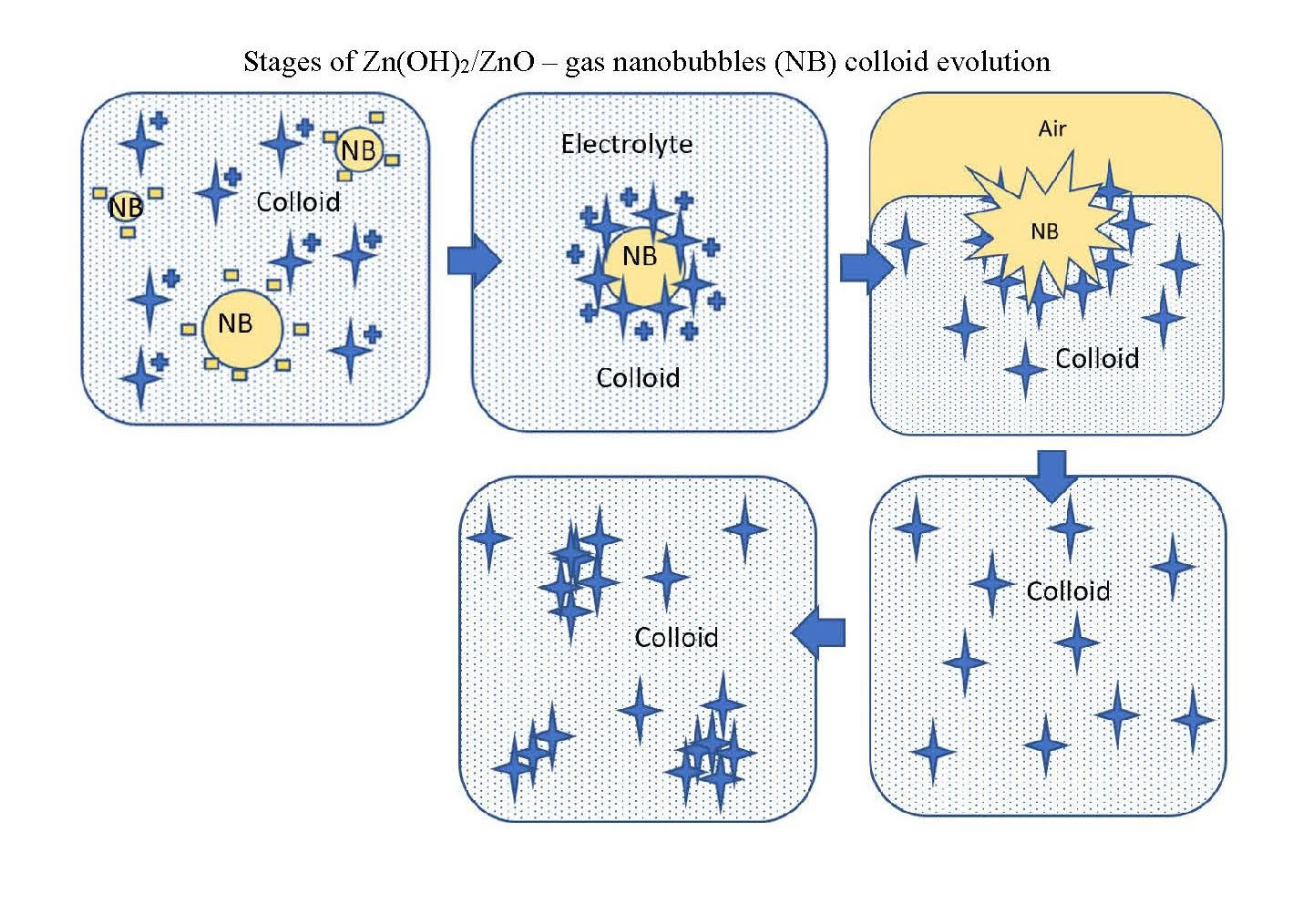Nanosystems: Phys. Chem. Math., 2023, 14 (2), 231–241
Colloidal-chemical mechanism of Zn(OH)2–ZnO layer formation at the glass – ammonia solution – Zn(II) interface
Evgeny V. Polyakov – Institute of Solid State Chemistry of Ural Branch of Russian Academy of Sciences, Ekaterinburg, Russia
Maria A. Maksimova – Institute of Solid State Chemistry of Ural Branch of Russian Academy of Sciences, Ekaterinburg, Russia
Julia V. Kuznetsova – Institute of Solid State Chemistry of Ural Branch of Russian Academy of Sciences, Ekaterinburg, Russia
Larisa Yu. Buldakova – Institute of Solid State Chemistry of Ural Branch of Russian Academy of Sciences, Ekaterinburg, Russia
Corresponding author: Evgeny V. Polyakov, polyakov@ihim.uran.ru
PACS 81.15.-z
DOI 10.17586/2220-8054-2023-14-2-231-241
ABSTRACT Thermodynamic and experimental studies of Zn(OH)2/ZnO particle formation conditions in the model of closed system Zn2+–NH3,aq–NH3,gas–H+–OH-–H2O–N2,gas (1), which often occurs in the process of synthesis of zinc oxide nanoparticles and films by chemical bath deposition (CBD) methods, were carried out.
It was shown that the driving force for the formation and growth of Zn(OH)2/ZnO particles in the initially homogeneous system (1) at 25 °C is the difference in the chemical potential of particles at the initial temperature (unsaturated system) and the synthesis temperature (supersaturated system). Using vibrational spectroscopy, X-ray phase and chemical analysis, diffuse light scattering and electrophoresis methods, it was found that the phase transformation of Zn(OH)2 into ZnO takes place in the region of 85 – 90 °C. The colloid-chemical transformation of Zn(NH3)42+ ionic particles into colloidal polycrystals of Zn(OH)2/ZnO composition was established for the first time to be a staged process. The first stage of the process in the solution volume is localized at the gas nanobubble-solution interface as a result of rapid formation, growth and removal of gas nanobubbles from the solution. The interaction of positively charged Zn(OH)2 nanoparticles with the surface of larger negatively charged gas nanobubbles creates colloidal aggregates “bubblejjsurface film of hydroxide nanoparticles”. Their adhesion forms an openwork foam-like structure of the colloid in the solution and in the film on the interfaces at
the first stage of synthesis. After degassing of the electrolyte solution, the second stage develops, consisting of the nucleation and ionic-molecular growth of Zn(OH)2/ZnO particles from the supersaturated solution, their distribution between the solution and the electrolyte – reactor wall – air interfaces. The film growth at this stage is regulated by the difference in surface charges of the double electric layer of the interface and polycrystalline colloidal particles. In the solution and on the interface, columnar Zn(OH)2/ZnO structures grow as volumetric stars with conical hexagonal spikes.
KEYWORDS Zn(OH)2, ZnO, layer, formation, glass, interface, mechanism, colloidal-chemical, NH3 solution.
ACKNOWLEDGEMENTS This study was performed in the framework of the state-financed topic AAAA-A19-119031890028-0 at ISSC UB RAS.
FOR CITATION Polyakov E.V., Maksimova M.A., Kuznetsova Yu.V., Buldakova L.Yu. Colloidal-chemical mechanism of Zn(OH)2–ZnO layer formation at the glass – ammonia solution – Zn(II) interface. Nanosystems: Phys. Chem. Math., 2023, 14 (2), 231–241.
[In Russian] Е.В. Поляков, М.А. Максимова, Ю.В. Кузнецова, Л.Ю. Булдакова
Кинетика роста слоев Zn(OH)2–ZnO из аммиачных растворов Zn(II) на поверхности стекла
АННОТАЦИЯ Проведены термодинамические и экспериментальные исследования условий образования частиц Zn(OH)2/ZnO в модельной замкнутой системе Zn2+–NH3,aq–NH3,gas–H+–OH-–H2O–N2,gas (1), которая часто возникает при синтезе наночастиц и плёнок оксида/гидроксида цинка методами химического осаждения в ванне (CBD). Показано, что движущей силой образования и роста частиц Zn(OH)2/ZnO в первоначально однородной системе (1) при 25 °C является разница в химическом потенциале частиц при исходной температуре (ненасыщенная система) и температуре синтеза (пересыщенная система). С помощью колебательной спектроскопии, рентгенофазового и химического анализа, методов диффузного рассеяния света и электрофореза установлено, что фазовое превращение Zn(OH)2 в ZnO происходит при 85 – 90 °C. Впервые установлено, что коллоидно-химическое превращение ионных частиц Zn(NH3)42+ в коллоидные поликристаллы состава Zn(OH)2/ZnO является стадийным процессом. Первая стадия превращения происходит в объёме раствора. Она локализуется на границе раздела «нанопузырек газа – внешний раствор» в результате быстрого образования, роста и удаления газовых нанопузырьков из раствора. Взаимодействие положительно заряженных наночастиц Zn(OH)2 с поверхностью более крупных отрицательно заряженных газовых нанопузырьков создаёт коллоидные агрегаты «пузырёк||поверхностная плёнка гидроксидных наночастиц». Их адгезия образует ажурную пеноподобную структуру коллоида Zn(OH)2 в растворе и в плёнке на границах раздела газ-жидкость на первом этапе синтеза. После дегазации раствора электролита развивается вторая стадия, заключающаяся в нуклеации и ионно-молекулярном росте частиц Zn(OH)2/ZnO из пересыщенного раствора, их распределении между раствором и границей раздела электролит – стенка реактора – воздух в виде плёнки. Рост плёнки на этой стадии регулируется разницей в поверхностных зарядах двойного электрического слоя границы раздела и поликристаллических коллоидных частиц. В растворе и на границе раздела столбчатые структуры Zn(OH)2/ZnO растут в форме объёмных звёзд с коническими гексагональными шипами.
КЛЮЧЕВЫЕ СЛОВА Раствор, Zn(NH3)42+, коллоид, образование, Zn(OH)2/ZnO, газ, нанопузырьки, поверхность, межфазная, плёнка, рост, механизмы
